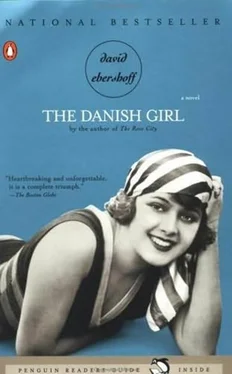“Nobody expects her to win,” Carlisle said of the American. He was holding his hand to his forehead to block out the sun. His jaw was exactly the same as Greta’s: square, a bit long, pegged with a mouthful of good teeth. Their skin was the same, too: brown after only an hour of sun, a bit coarse in the throat. It was a throat Einar used to kiss passionately in the night. It was what he had liked most about Greta, even more than kissing her mouth: bringing his lips to her long throat and sucking lightly, licking in a little swirling motion, nipping, drilling away at the spot on her throat that was open and veined.
“Sometime I’d like to visit California,” Einar said. The match had begun, the American serving. She tossed the ball high, and Einar could almost see the muscles in her shoulder turn as she brought her racquet through the air. Greta often said she thought of oranges hitting the ground when she heard a tennis ball; Einar thought of the ryegrass court behind the brick villa, the powdered-sugar lines blowing in the wind.
“Does Greta ever say anything about it?” Carlisle asked. “About coming home?”
“I’ve heard her say a lot would have to change before she would go back.” Greta once said that neither of them would fit in there, in Pasadena, where rumor crossed the valley as rapidly as a blue jay in the breeze. “It’s not a place for you and me,” she had said.
“I wonder what she means,” Carlisle said.
“You know Greta. She doesn’t want people talking about her.”
“But in some ways she does.”
The American girl won the first game, her drop shot barely lifting over the net cord and then falling deceptively to the clay.
“Have you ever thought about coming out for a visit?” Carlisle asked. “To California? Maybe come out for the winter to paint?” He was fanning himself with the program; he held his bad leg out, the knee locked. “Come out and paint the eucalyptus and the cypress? Or one of the orange groves? You’d like it.”
“Not without Greta,” Einar said.
And Carlisle, who at the same time was and was not exactly like his sister, said, “But why not?”
Einar crossed his legs, his foot shifting the wicker chair in front of him. The girl from Lyon sailed across the court, her skirt taut, to return a backhand from the sneaky American, hitting the dirty white ball up the line for a winner. The crowd, which was handsome and hatted and collectively smelled like lavender and lime, erupted into a cheer.
Carlisle turned to Einar. He was smiling and applauding, and his forehead was beginning to sweat; and then, when the stadium fell silent to allow the girl from Lyon the peace to serve, he said, “I know about Lili.”
Einar could smell the clay, its rich dustiness, and the wind blowing through the poplars. “I’m not sure I know what you’re-”
But Carlisle stopped him. Carlisle placed his elbows on his knees and stared at the court and began to tell Einar about the letters Greta had been writing over the past year. They would arrive once a week fat in the mailbox, a half-dozen sheets of blue tissuey paper covered with her cramped words; she wrote them in such a fury that she didn’t use margins, the small tight writing crossing the page from edge to edge. “There’s someone called Lili,” she wrote for the first time maybe a year before. “A girl from the bogs of Denmark whom I’ve taken in.” The letters would describe Lili making her way around Paris, kneeling to feed the pigeons in the park, her skirt bunching around her on the gravel path. They described Lili sitting for hours on the stool in Greta’s studio on the rue Vielle du Temple, the light from the window on her face. The letters arrived almost weekly, a summary of the previous days with Lili. They never mentioned Einar, and when Carlisle would reply “How’s Einar?” or “My best to Einar,” and even once, “Isn’t this your tenth wedding anniversary?” Greta never acknowledged the inquiry.
One day, after about six months of the weekly letters, a slim envelope arrived in Carlisle’s mailbox. He remembered the day, he told Einar, because the black January rains had been falling for a week, and his leg was aching is if it had been hit by the buggy only the previous afternoon. He went down his driveway to the mailbox, his bamboo cane in one hand and an umbrella in the other. The ink on the envelope smeared in the rain, and he opened it in his foyer, which was dark with paneled Pasadena oak. He read the letter as the water dripped from his hair onto the single page. “Einar is leaving me,” Greta’s letter began. “You are right. After ten years he is leaving me.” Immediately Carlisle considered driving over to the post office on Colorado Street and sending a telegram. He put on his rubber coat while reading the rest of the letter, and it was only then that Carlisle began to understand what Greta meant.
A second letter arrived the next day, and then another, the day after. What followed was an almost daily account of Lili. The pages were just as crammed with description as before, but now tiny sketches of a girl’s face would interrupt the sentences: Lili in a hat pinned with dry violets; Lili reading Le Monde ; Lili staring up, her eyes round, at the sky.
“Then Greta started mailing me sketches from her notebook. Studies for her paintings of Lili. She sent me the one of Lili in the lemon grove. And Lili in the wedding party.” He stopped while the American girl served. “They’re beautiful. She’s beautiful, Einar.”
“Then you know.”
“It didn’t take me long to understand,” Carlisle said. “Of course I don’t know much about this,” he said. A small brown bird landed on the rail of the box. Its head revolved, looking for seed. “But I’d like to help. I’d like to meet Lili. To see if there’s anything I can do. You see, it’s Greta’s way of doing things, sending the letters and drawings. She ’d never come out and ask for help. But I can tell she needs it. I can tell she thinks you could stand some help, even more than she can give you.” And then, “It’s hard on her. You can’t forget that this is just as hard on her.”
“She said that?”
“Greta would never say anything like that. But I can tell.”
Einar and Carlisle watched the tennis. The day was warm, the girls toweling their faces. “Have you seen a doctor?” Carlisle asked.
Einar told him about Dr. Hexler. Just saying his name brought back the nausea; he could nearly feel a throb in his gut.
“I don’t see why you’d go to a medical doctor,” Carlisle said. “Shouldn’t you talk to someone about how you feel? About what you’re thinking? I’m going to take you to someone. I’ve looked up some names, and I’m going to take you to talk to someone who just might help. Help you resolve this once and for all. Not to worry, Einar. I have an idea.”
And this was what Einar remembered most: the sight of Carlisle’s long legs out of the corner of his eyes, the bad leg now at a hard angle. And the American girl on the court becoming sweaty, a wet spot developing on her blouse just beneath her breasts. And her face, which was dark and plain; and how her head was large and her arms long, and there was something about her that didn’t seem right. Like the thin tendril of a vein that pulsed up her forearm. Or the shadow above her lip. And how the whole stadium was rooting against her, more and more as she took a bigger lead against the blond girl from Lyon. It seemed the whole world was against her-everyone except Carlisle, who leaned over and said, “Don’t you want her to win? Wouldn’t it be more fun for her to win?”
First Carlisle drove Einar to see Dr. McBride. He was an American psychiatrist connected to the embassy, his practice on the rue de Tilsitt, down the street from the passport office. Dr. McBride had a wiry bush of hair and a mustache that was black and gray. He was heavy in the throat and stomach, and he wore white shirts starched as stiff as paper. He was from Boston, and during Einar’s meeting with him he kept referring to himself as a “black Irishman.” When he smiled, there was a flash of gold at the back of his mouth.
Читать дальше












